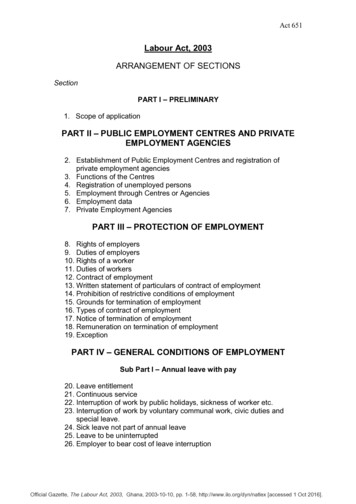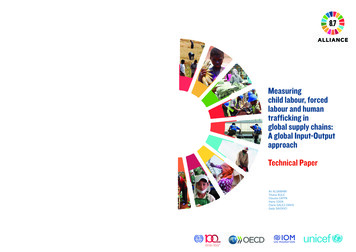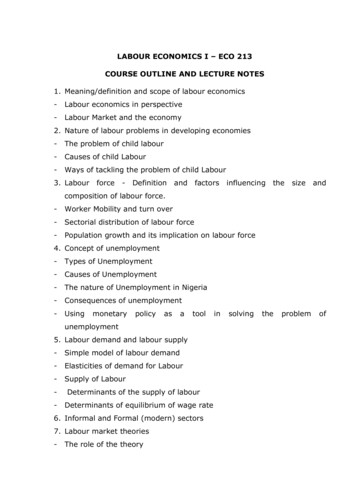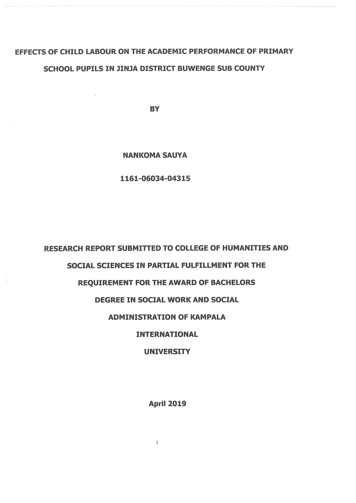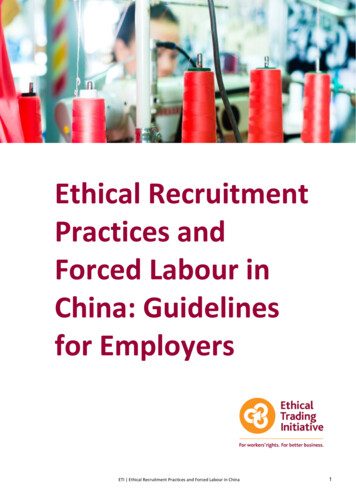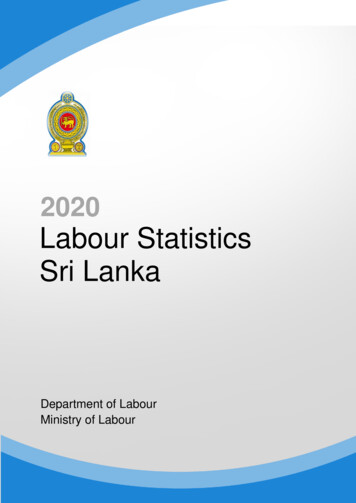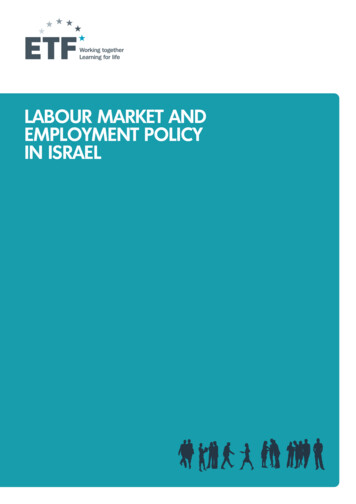
Transcription
LABOUR MARKET ANDEMPLOYMENT POLICYIN ISRAEL
The contents of this paper are the sole responsibilityof the author and do not necessarily reflect the viewsof the ETF or the EU institutions.ISBN -N European Training Foundation, 2015Reproduction is authorised provided the sourceis acknowledged.
LABOUR MARKET ANDEMPLOYMENT POLICYIN ISRAELPrepared for the ETF by Lilach Lurie, PhDPREFACE31.THE ISRAELI LABOUR MARKET42.KEY ACTORS IN LABOUR MARKET POLICIES63.NEW EMPLOYMENT LAWS74. PASSIVE LABOUR MARKET POLICIES: UNEMPLOYMENT BENEFITSAND INCOME SUPPORT BENEFITS85. JOB PLACEMENTS: THE PUBLIC EMPLOYMENT SERVICEAND PRIVATE EMPLOYMENT SERVICES95.1The Public Employment Service . . . . . . . . . . . . . . . . . . . . . . . . . . . . . . . . . . . . . . . . . . . . . 95.2 Employment centres for the Arab and ultra-Orthodox communities. . . . . . . . . . . . . . . . . . 96. LIFELONG LEARNING: SCHOOL, TERTIARY EDUCATIONAND VOCATIONAL TRAINING106.1School and tertiary education. . . . . . . . . . . . . . . . . . . . . . . . . . . . . . . . . . . . . . . . . . . . . . . 106.2Matching skills to labour market demands. . . . . . . . . . . . . . . . . . . . . . . . . . . . . . . . . . . . 106.3Vocational training . . . . . . . . . . . . . . . . . . . . . . . . . . . . . . . . . . . . . . . . . . . . . . . . . . . . . . . 117.EFFORTS TOWARD A NATIONAL WELFARE-TO-WORK PROGRAMME128.ACTIVE LABOUR MARKET PROGRAMMES TOWARD AT-RISK YOUTH138.1Youth centres. . . . . . . . . . . . . . . . . . . . . . . . . . . . . . . . . . . . . . . . . . . . . . . . . . . . . . . . . . . 138.2Afikim. . . . . . . . . . . . . . . . . . . . . . . . . . . . . . . . . . . . . . . . . . . . . . . . . . . . . . . . . . . . . . . . . 13
2LABOUR MARKET AND EMPLOYMENT POLICY IN ISRAEL9.ISRAELI DEFENCE FORCES PROGRAMMES TOWARD AT-RISK YOUTH1410. MEASURES TO SUPPORT THE GROWTH OF SMALLAND MEDIUM-SIZED ENTERPRISES1511.17CONCLUSIONS AND RECOMMENDATIONSACRONYMS18BIBLIOGRAPHY19
3PREFACEThe European Training Foundation (ETF) has provided regular input to the European Commission (Directorate-Generalfor Employment) throughout the process of structured Euro-Mediterranean policy dialogue on employment that wasinitiated in 2008 to address poor employment prospects in the region. Reform of the European Neighbourhood Policyin 2011 placed further importance on job creation and inclusive growth in the region (European Commission, 2011a;and 2011b) and the ETF provided support in the form of three employability reports. These were presented to theEuromed High-Level Working Groups on Employment and Labour in 2007, 2009 and 2011, in preparation for theministerial conferences. The reports aimed to contribute to policy dialogue between the European Union, the ETF andpartner countries through the provision of good quality analysis of employment policy and employability in the region.The process continued in 2013, with the launch of a further round of ETF analysis that looked into employmentpolicies in selected countries of the region. This new generation of country reports has moved on from analysisof labour market trends and challenges to the mapping of existing employment policies and active labour marketprogrammes (ALMPs), including some assessment of the outcomes and effectiveness of these measures inaddressing employment challenges. Each report also includes a short description of the socio-economic context in thecountry, the emergence of new players and actors, and any recent policy changes (government, donors, funding, etc.).This report was drafted by Lilach Lurie, PhD. The desk review and statistical data analysis are complemented withinput provided by stakeholders in government offices, civil society organisations and academia. These includedcontributions from the Ministry of Economy (Commissioner of Employment and the Training Guidance Division), theSmall and Medium Business Agency (SMBA), the Israeli Civil Service, the Israeli Central Bureau of Statistics (CBS),the National Insurance Institute (NII), Histadrut, the Van-Leer Research Institute, Tel-Aviv University, the HebrewUniversity, and the Micro-Business and Economic Justice Programme. Officials from these bodies were interviewedby the local expert to provide opinions on employment policies. This report reflects the findings of these interviews,but the views expressed in this report do not necessarily represent those of the stakeholders interviewed.Daiga Ermsone and Lida Kita, ETFSeptember 2014
4LABOUR MARKET AND EMPLOYMENT POLICY IN ISRAEL1. THE ISRAELI LABOUR MARKETIsrael has enjoyed strong economic growth over the last decade and its labour market has fared relatively well inrecent years (OECD, 2010a; and 2013a). In 2012, the national unemployment rate was relatively low, at 7% againstan OECD average of 8.2%1. Labour participation for the working age population (15-64) was 71.5% to an OECDaverage of 70.9%2, with a rate for the entire population aged 15 at 63.6% (TABLE 1.1).TABLE 1.1 LABOUR FORCE PARTICIPATION RATES BY AGE, 2012 (%)70 .99084.868.211.669.3ArabsArabwomenArab 31.91.127.113.851.774.687.585.168.58.766.1Sources: CBS, 2012a; and 2012bIn the same year, the unemployment rate for Israeli youth (15-24) was only 12.1%, against an OECD average of16.3%, and Israel’s youth labour force participation rates (49.5%) were higher than the OECD average (47.4%)3.These high rates of youth employment are largely due to the fact that the Israeli Central Bureau of Statistics (CBS)has included the figures for youth in compulsory military service within the labour force figures since 2012 (OECD,2013a, p. 18)4.Despite the relatively good employment rates, Israel also has high levels of poverty and income inequality (OECD,2013a). Income dispersion, as measured by the Gini coefficient, is among the widest in the OECD area (0.3777 asof 2011)5. Poverty rates are highest among Arab and ultra-Orthodox minority groups (OECD, 2013a, p. 17). Bothgroups (specifically Arab women and ultra-Orthodox men) experience high rates of unemployment and Table 1.1clearly shows that only 27% of Arab women are employed. Both of these groups have a lack of employment skillswhich are at least partly a result of poor education systems (Ben-David, 2014)6. The Israeli labour market is alsocharacterised by a high rate of non-standard forms of work (OECD, 2013a).In 2013, 16.6% of all Israeli youth aged 15-29 were unemployed or inactive, and could be classed as not ineducation, employment or training (NEET) (TABLE 1.2)7. These figures are close to the OECD average (OECD,2014b), with only slightly higher rates of NEETs aged 15-24 in Israel (15.7% against 13% [CBS data 2013; andOECD, 2014b]). Table 1.2 shows relatively high numbers of NEETs in Israel during the transition from school to thearmy (26.8% of 18 year-olds are considered NEETs) and in the later transition from army service to work or highereducation (20.3% of 21 year-olds are considered NEETs)8.1OECD StatExtracts: http://stats.oecd.org/Index.aspx?DatasetCode LFS SEXAGE I R. In January 2014 Israel’s unemployment rate was 5.9% only. See CBS at: www.cbs.gov.il/reader/?MIval cw usr view Folder&ID 141.2Ibid.3OECD StatExtracts: http://stats.oecd.org/Index.aspx?DatasetCode LFS SEXAGE I R (19 March 2014).4See also OECD, 2014a, p. 30.5http://stats.oecd.org/Index.aspx?DataSetCode IDD.6See also OECD, 2014a on skills mismatch.7The concept of NEETs refers to young people (aged 15-29 or 15-24) who do not hold a job, do not participate in training and are not students. NEETs are considered to be‘at risk’ as they are jobless and inactive and lack access to learning opportunities (ETF, 2014, p. 3).8Men aged 18-21 and women aged 18-20 are expected to perform compulsory military service in the Israeli army.
1. THE ISRAELI LABOUR MARKET5Groups of young people who do not serve in the army (Arabs, ultra-Orthodox Jews and people with disabilities) haveparticularly high numbers of NEETs, with the Arab population presenting the highest numbers of all. In 2009, 40%of Arab youth aged between 18 and 22 were inactive (NEETs) compared with only 17.3% of Jewish youth (Ecksteinand Dahan, 2011).TABLE 1.2 NEETS BY AGE AND SEX (AGE RANGE 15-29), 2013 (%)AgeNEET 25.518.92911.924.317.9Total14.019.216.6Source: CBS data 2014
6LABOUR MARKET AND EMPLOYMENT POLICY IN ISRAEL2. KEY ACTORS IN LABOUR MARKETPOLICIESLeading government players in the labour market and social security sector include sub-departments within theMinistry of Economy9, Israel’s social partners (the Histadrut Federation of Trade Unions and the employers’ unionHitachdut Hatasianim), the National Insurance Institute (NII) of Israel (responsible for providing unemploymentbenefits and income support), and the Ministry of Finance (with schemes such as the negative income taxprogramme)10. The Ministry of Education plays a major role with regard to compulsory education11.In the past few decades, Histadrut, Israel’s major trade union, has lost control over healthcare and pension plans, butthe entity still sits alongside the government and the Hitachdut Hatasianim on the tri-pillar roundtable responsible fordrawing up employment and economic policies (Mundlak, 2007, pp. 121-124). In June 2014, Israel’s social partnerssigned a collective agreement that compelled private sector employers with more than 100 employees to employworkers with disabilities. Most Israeli workers (56%) are covered by collective agreements, but only 25% belongto a union (down from 80% in the 1980s) (Haberfeld et. al., 2010; Cohen et al., 2003; and CBS, 2013b). A newemployee union, the Koach La Ovdim – Democratic Workers’ Organisation has appeared in recent years.Non-governmental organisations (NGOs) representing specific groups of employees play a more important role thanin the past. These include entities such as the Israel Women’s Network (representing women employees); the KavLaOved – Worker’s Hotline (representing disadvantaged workers including foreign workers); and Waak-Maan (anemployee union representing Arab workers).9Entities include (i) the Commissioner of Employment; (ii) the Industrial Relations Department; (iii) the Small and Medium Enterprise Agency; (iv) the Israeli EmploymentService Authority; (v) the Training Guidance Division; (vi) the Equal Employment Opportunity Commission; and (vii) the Director of Research and Economics.10See www.mahanak.org.il/ [in Hebrew].11On the role of the Ministry of Education with regard to technical and vocational education and training, see ETF, 2012.
73. NEW EMPLOYMENT LAWSFrom the outset, Israel enacted employment laws to provide all workers with decent employment rights, ensuringbasic entitlement to: a minimum wage, annual leave, paid sick leave, an occupational pension, protected workinghours, a right to severance pay and the right to a safe workplace12. Special laws forbid the employment of youthunder the age of 15 and impose strict limits on youth working hours13, which may go some way toward explainingthe low employment rates of teenagers in Israel. In spite of the strict legislation, however, many workers in Israeldo not actually enjoy their rights (OECD, 2013a). The problem of rights realisation is especially significant among themost disadvantaged groups of employees (contract workers, low-paid workers, Arabs, ultra-Orthodox and foreignworkers).In the last three years, Israel has made significant efforts to increase the enforcement of employment laws andto promote equality in employment. In December 2011, the Israeli Parliament (the Knesset) enacted The Lawfor Increased Enforcement of Labour Laws (2011), enabling employment inspectors (on behalf of the Ministry ofEconomy) to impose administrative fines on employers who violate employment rights. The law also includes specialprotection for contract workers by making the end-user (the service ‘buyer’) responsible for enforcement (OECD,2013a). Under the stipulations of Article 17, the Ministry of Economy publishes the names of employers who violatethe law and who receive fines on a new website14.Over the years, the Knesset also enacted many laws to promote employment equality and prevent employmentdiscrimination15. The Civil Service Appointment Law of 1959 requires the public service to take affirmative action inhiring women, Arabs and Ethiopian Jews16. The Equal Employment Opportunities Law of 1988 forbids employmentdiscrimination on account of a person’s sex, sexual tendencies, personal status or on the basis of their age, race,religion, nationality, country of origin, views, party or duration of reserve service (Article 2). In 2008, the Knessetestablished the Equal Employment Opportunity Commission (EEOC)17 to prevent employment discrimination andenforce anti-discrimination legislation.12For a list of Israel’s employment laws in English, see the Ministry of Economy website at: 25104B45FBB1.htm.For a historical review of Israel’s employment law legislation, see Mundlak, 2007. The right to an occupational pension is regulated in an extension order.13Youth Labour Law (1953); and Apprenticeship Law (1953).14See ications/Pages/default.aspx15Examples of antidiscrimination laws include the Employment Equal Opportunities Law 1988; Employment of Women Law 1954; Male and Female Workers Equal PayLaw 1996; and Equal Rights for Persons with Disabilities Law 1998.16As of the end of 2011, the Ethiopian Jewish community in Israel numbered approximately 119,700. Most of the community immigrated to Israel in two successivewaves, in 1984 and 1991. See Myers-JDC-Brookdale Institute, 2012.17The EEOC is a department within the Ministry of Economy.
8LABOUR MARKET AND EMPLOYMENT POLICY IN ISRAEL4. PASSIVE LABOUR MARKETPOLICIES: UNEMPLOYMENT BENEFITSAND INCOME SUPPORT BENEFITSPassive labour market policies are Israel’s main tool in protecting individuals from social exclusion. NII provides twomain benefits that are supposed to provide an economic safety net for the unemployed and inactive population:unemployment benefit and income support benefit. Unemployment benefits provide an unemployed person witha source of subsistence for the duration of his/her unemployment, until he/she manages to find work (NII website,2014). In recent decades, the Israeli government has revised eligibility requirements for both programmes and hasreduced payment rates, partly in response to budgetary constraints but also to counter the ‘unemployment trap’caused by the provision of benefits (Gal, 2005). Israel managed to dramatically decrease the number of incomesupport recipients from 143,640 in 2008 to 133,800 in 2013 (TABLE 4.1).One of the major challenges facing Israel now, is how to get welfare recipients into employment. Israel spendsa substantial amount on direct support for welfare recipients (although the figure is relatively low in internationalcomparisons), some of which could be channelled into ALMPs. In 2012, NII spent over ILS 2.4 billion on incomesupport benefit for 133,800 recipients (TABLES 4.1 and 4.2). Moreover, in 2002-03 the Knesset tightened benefiteligibility criteria, including changes to the income test and in the employability test, while also reducing the amountof the benefits (NII, 2004). These changes mean that, in 2014, many of the unemployed and inactive population,especially the young, are no longer entitled to unemployment or income support benefits (Maron, 2014).TABLE 4.1 NUMBER OF INCOME SUPPORT BENEFICIARIES (AND THEIR SPOUSES), Number ofbeneficiaries143,640143,553140,808Source: NII, 2013, p. 88TABLE 4.2 INCOME SUPPORT PAYMENTS, 2008-12 (MILLION ILS)PaymentsSource: NII, 2013, p. 92200820092010201120122,3922,4822,5272,4772,493
95. JOB PLACEMENTS: THE PUBLICEMPLOYMENT SERVICE AND PRIVATEEMPLOYMENT SERVICES5.1 THE PUBLIC EMPLOYMENT SERVICEThe Public Employment Service (PES) plays an active role in getting welfare recipients into employment. TheIsraeli PES has 71 chambers employing a total of 593 employees. The PES major role is to provide services linkingjobseekers with employers seeking employees (Employment Service Law 1959, Article 2). In 2013, PES placed44,454 out of a total of 506,540 registered jobseekers in jobs (Israeli Employment Service Annual Summary 2014). Inhalf of all cases (21,753) the placement was not successful over time.PES also provides guidance and counselling for unemployed jobseekers (OECD, 2014) including assistance in writingCVs, preparation for job interviews and advice on job placements and vocational training (PES website). In 2013, PESstaff provided employment consultancy to 34,905 jobseekers (Hirsh, 2014).PES cooperates with other bodies on vocational training and vocational guidance, in particular the Ministry ofEconomy (Israeli Employment Service website; and OECD, 2014). In 2013, PES and its partner agencies providedthe following services to jobseekers: occupational psychological counselling (2,670 jobseekers); vocational training(Ministry of Economy, 1,967 jobseekers); personal training vouchers (Ministry of Economy, 2,680 jobseekers); jobsearch workshops (5,793 jobseekers); occupational Hebrew courses (452 jobseekers) (Hirsh, 2014).The Israeli PES currently operates under some limitations. The constrained annual budget of ILS 191 million (in2013) means that there are a relatively small number of employees (593) to work with a large body of jobseekers(506,540 jobseekers in 2013)18, and several of the PES services have recently been passed over to private entities.Also, most applicants who contact PES do so in order to apply for unemployment or income support benefits ratherthan for any other purpose, as registration with the entity is a necessary step in this process (State Comptroller,2011, pp. 1119-1120; Israeli Employment Service Annual Summary 2014). Eligibility criteria for both programmes arevery strict and, consequently, young people ineligible for unemployment benefits or income support will generallynot register with PES. In 2013, only 67,321 jobseekers aged between 18 and 24 registered with the Israeli PES(Hirsh, 2014)19.5.2 EMPLOYMENT CENTRES FOR THE ARABAND ULTRA-ORTHODOX COMMUNITIESA multi-year plan for economic and social development in the Arab community aims to have 21 special employmentcentres open by the end of 2014, with 18 already open as of June 2014 (Commissioner of Labour, 2014). The samesource states that, in 2012, seven employment centres were currently active serving 4,000 clients and placing 40%of them (1,800 recipients) in jobs.For the ultra-Orthodox community, eight special employment centres were developed and opened in tandem(updated to June 2014)20.All of the employment centres in the Arab and ultra-Orthodox communities are outside the remit of the Israeli PES.18Data from Hirsh, 2014.19Hirsh (2014) states that there are no registered jobseekers under 18.20See http://mafteach.org.il/
10LABOUR MARKET AND EMPLOYMENT POLICY IN ISRAEL6. LIFELONG LEARNING: SCHOOL,TERTIARY EDUCATION ANDVOCATIONAL TRAINING6.1 SCHOOL AND TERTIARY EDUCATIONIsrael has a well-educated population (OECD, 2013b). Education is compulsory between age 5 and 18, with freeeducation provided between age 3 and 18 (OECD, 2014a, p. 14). Some 90% of Israeli youth have at least uppersecondary qualifications; a rate higher than the OECD average of 82% (op. cit., p. 15). The majority of secondaryeducation students (60%) enrol in general academic upper secondary education, one third opt for technologicalprogrammes, and 3% opt for industrial schools or apprenticeship pathways (op. cit., p. 14).General and technological upper secondary education both lead to the ‘Bagrut’ matriculation exam that is a normalrequirement for entry into academic post-secondary education (OECD, 2014a). In 2007, 42% of 25-34 year-oldIsraelis had a tertiary qualification; a figure significantly higher than the OECD average of 34%. In 2011, there weremore women than men with tertiary education (OECD, 2013b). Only 26% of 25-34 year-old Arabs hold a tertiaryqualification and tertiary attainment is also very low among the ultra-Orthodox population (op. cit.). Israel’s annualexpenditure per student by educational institutions (from primary to tertiary education) is almost a third less than theOECD average (OECD, 2013c).The system of vocational schools (technological and industrial schools) in Israel has been discussed extensively inseveral ETF, OECD and Knesset reports (see for example ETF, 2012; and 2013; OECD, 2014a; and Vargen and Natan,2008). Several of the vocational schools are regulated by the Ministry of Economy, which is also responsible for theregulation of post-secondary vocational education, while others are regulated by the Ministry of Education.TABLE 6.1 FIRST-YEAR STUDENT ENROLMENTS, BEGINNING OF 2011/12 SCHOOL YEAR (%)UniversitiesPractical engineeringand technician programmesAcademic colleges381448Source: OECD, 2014a6.2 MATCHING SKILLS TO LABOUR MARKET DEMANDSOECD reports (2014a, p. 30) state that the Israeli economy is threatened by a growing skills shortage. Employersare voicing concern over the inadequacy of vocational skills among school-leavers and, as the highly-skilled migrantsfrom the former Soviet Union reach retirement age, there will be a substantial exacerbation of the skills shortages.Enhanced vocational provision is also necessary to increase economic activity in the growing Arab Israeli and ultraOrthodox populations (OECD, 2014a).In 2013, the Ministry of Economy set up a new Jobs Rated website that aimed to fulfil two purposes. The first wasto enable youth (and other populations) to make better-informed decisions on their educational choices, and thesecond was to enable the regulators (including the Ministry of Economy) to improve compatibility between laboursupply and demand within the economy.This new website strengthens ties between the labour market and education and includes information on the currentdemand for various professions in different geographical areas, giving a high rating to those professions with agood demand for workers and a low rating to those with poor demand. The website also shows the average wages
6. LIFELONG LEARNING: SCHOOL, TERTIARY EDUCATION AND VOCATIONAL TRAINING11for each profession. As of June 2014, the website gives very high ratings to the following professions: registerednurse (681 positions; ILS 7,879); academic in computer science (502 positions; ILS 23,739), construction worker(2,064 positions; 5,634 NIS), computer practical engineer (302 positions; ILS 14,477), electrician (1,836 positions;ILS 6,336) and teacher (553 positions; ILS 8,796).6.3 VOCATIONAL TRAININGVocational training is an important tool in improving the compatibility between labour offer and the supply needsof the economy. Moreover, vocational training has the potential to integrate individuals into employment andto promote mobility in the labour market (King and Eyal, 2012). Within the Ministry of Economy, the IsraeliManpower Training and Development Bureau (the Bureau) regulates the government vocational training systemfor adults (King and Eyal, 2012), working for a target population of jobseekers that includes discharged soldiers, theunemployed, immigrants and unemployed university graduates (Ministry of Economy, 2013). The Bureau regularlychecks and evaluates the numbers of job placements of its graduates.An evaluation study from 2014 examined the employment status of the 2011 cohort of vocational training graduatestwo years after completing their studies. The study found that most graduates (78.1%) were working in 2013 (twoyears after completing their training). However, most graduates (55%) were not working in the field in which theyhad trained. The study also identified several sectors where most graduates did work in the field of training twoyears after graduation, and these were: metal and machinery (58.6%), day care workers (53.7%), hospitality (53.2%),electricals and electronics (50.7%) (Porat, 2014).The Bureau has developed some new programmes in recent years, including a voucher scheme that has run since2007. This training voucher enables participants to approach a training institute of their choice and to receive partialfunding for the course selected (Ministry of Economy website; Ministry of Industry, Trade and Labour, 2012). Thehighest priority target groups are ultra-Orthodox men, Arab women and people with disabilities (Ministry of Economywebsite). The Bureau also supports on-the-job training opportunities through training while working or via specialclasses in the workplace (Ministry of Industry, Trade and Labour, 2012).However, vocational training in Israel is also facing some major challenges. The first of these is the fact that there isno statutory right to vocational training21 in a system where the Ministry of Economy determines the eligibility criteriafor state-funded vocational training. These eligibility criteria are only published in part and they are subject to frequentchange. Most recipients of vocational training are allowance seekers referred through PES, and the strict eligibilityconditions for unemployment benefits mean that less than 1% of all unemployed people received vocational trainingin recent years (NII, 2013a). Furthermore, budgetary constraints place other limitations on the number of vocationaltraining openings and eligibility conditions are tightly restricted (cf. OECD, 2014, pp. 35-36). Moreover, in 2012,the gross budget for vocational education for adults was given as ILS 84,000, but only half of the budget (ILS 44,768)was actually spent (Ministry of Economy, 2013). Lastly, alternative routes to training in the past relied extensivelyon union membership. In Israel, many collective agreements provide employees with a right to a training fund22and the Israeli Civil Service provides and funds comprehensive vocational training for its employees (Lurie, 2013).The effectiveness of these tools is doubtful due to the sharp decrease in union membership and there is a needto develop new mechanisms23.21The Public Employment Service Law of 1959 declares that PES will ‘cooperate with other bodies with regard to vocational training and vocational guidance’.22Employees and employers allocate money to the funds every month and the State provides tax benefits for money allocated to the funds. In practice, training funds inIsrael frequently serve as investment mechanisms rather than training tools.23One example of this is Maagalim – a new fund which finances training for senior workers. See http://magalim.org.il/
12LABOUR MARKET AND EMPLOYMENT POLICY IN ISRAEL7. EFFORTS TOWARD A NATIONALWELFARE-TO-WORK PROGRAMMEOver the last 15 years, welfare-to-work programmes have emerged all over the Western world. These programmesaim to transform ‘passive’ social security systems reliant mostly on benefits, into ‘active’ systems that place fargreater emphasis on engaging unemployed people in the labour market (Benish, 2014; and Paz-Fuchs, 2008). Overthe last few years, Israel has implemented several ALMPs.The Earned Income Tax Credit programme has been in operation since 2008, and this was expanded across thecountry in 2012 (OECD, 2013a, p. 10). The programme provides low-waged workers (above the age of 23 with atleast one child, or above the age of 55) with a work grant24. According to the NII the programme had reduced povertyamong young workers with children and senior workers in the year 2012 (NII, 2013b).The Investment Centre within the Ministry of Economy also provides wage subsidies to enterprises that employworkers in the periphery focussing on special groups of workers.In recent years, a series of ALMPs have been promoted by the Prime Minister’s Office (OECD, 2010a). In 2012,the Ministry of Economy appointed a senior official to lead employment policy development and regulation (OECD,2013a). These initiatives are being specifically targeted on groups with low participation rates in the labour marketsuch as Arab women, ultra-Orthodox men and social service users, and the measures used include: the creation ofemployment centres; expansion of vocational training programmes through the use of a voucher system; expansionof programmes to encourage business entrepreneurship; and the development of industrial parks (Ministry ofIndustry, Trade and Labour, 2012). Private contractors (and not PES) work in partnership with the TEVET EmploymentInitiative25 programme and play a major role in the design and implementation of new ALMPs.Between 2005 and 2010 Israel implemented two pilot welfare-to-work programmes (the Wisconsin programmes)with the help of private contractors26. The main objective was to reduce welfare expenditure by reducing the numberof people receiving income support, integrating these people into the labour market. However, in 2010, the Knessetabandoned the programmes in response to strong public opposition. These programmes were extensively studiedand evaluated by the Israeli government (Myers-JDC-Brookdale Institute and NII research reports 1-5), academicresearchers (e.g. Benish, 2014; and Maron, 2014) and international organisations (OECD, 2010; and 2013a). Theseevaluations identified the main flaw as being the emphasis on rapid integration into employment (‘work first’) withoutsufficient focus on job quality (Lurie, 2013a; and OECD, 2013a, p. 31).The Ministry of Economy is currently promoting a new welfare-to-work programme know
9 Entities include (i) the Commissioner of Employment; (ii) the Industrial Relations Department; (iii) the Small and Medium Enterprise Agency; (iv) the Israeli Employment Service Authority; (v) the Training Guidance Division; (vi) the Equal Employment Opportunity Commission; and (vii) the Director of Research and Economics.
